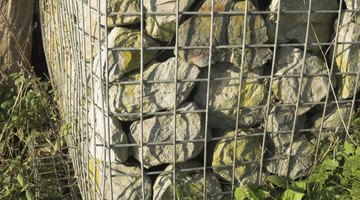How to Build a Gabion Wall
You can construct stone walls by assembling rectangular gabion baskets end to end and filling them with rocks. Gabions are wire cages filled with heavy material; they serve road construction and other civil-engineering projects, and they can serve as walls or decorative dividers for gardens.

The walls don't need a foundation and can flex with ground contours; they prevent erosion but let water flow through them. While gabion walls are labor-intensive, you can build them at low cost, especially if you can use rocks from the site.
Things You Will Need
- Gabion baskets or wire mesh
- Galvanized wire
- Wire cutters
- Pliers
- Hoe
- Spade
- Board the length of the wall
- Level
- Edging
- Weed mat
- Rocks
- Work gloves
Tip
Galvanized steel wire spirals let you join the edges of baskets or wire mesh rapidly and securely by twisting them into the joints.
Warning
If you are cutting heavy wire and wire mesh, wear protective goggles.
Site Preparation
-
Place stakes at the corners of the site where you intend to construct the gabion wall. Use the spade to dig up any grass or plants that would have roots under the wall.
-
Examine the earth under the wall. If it is soft soil or clay, dig down a few inches and fill the hole with gravel to give extra support to the weight of the wall.
-
Use the hoe to smooth the ground or gravel under the wall. Place the board on the ground and use the level to make sure the base of the wall is approximately level.
-
Place edging around the border of the site and place a weed mat over the ground under the wall to keep out weeds.
Installing the Wire Baskets
-
Buy prefabricated gabion wire baskets or buy wire mesh such as chicken wire or construction wire mesh. Make sure the wire mesh you buy is galvanized or otherwise coated to resist corrosion.
-
Place the wire baskets on the ground where you want to build the wall. For prefabricated baskets, if the sides are already attached to the base, lay them flat with the base in the right location. If the sides are not attached, place the base in the right location and place the sides in position around it. For wire mesh, cut a base and lid of equal size, two ends of equal size and two equal sides. Place the base in position and the sides around it.
-
For baskets, use the galvanized wire to wire up the corners and sides to form a rectangular basket. Leave the lid open so you can put in the rocks. For wire mesh, use the galvanized wire to wire up the corners and the sides of the rectangular basket, leaving the lid open.
Insert the Rocks
-
Place the rocks inside the wire baskets. Use on-site rocks if they give you the appearance you want and are larger than the wire mesh holes. If you can't use on-site rocks, buy the size and type of rocks you need.
-
Place flat rocks with the flat side facing outward and use angular or corner-shapes rocks for the corners. Use cement blocks for the middle of large gabion baskets to save rocks and speed filling of the baskets.
-
As you are filling the baskets, place wired cross braces every three to six inches of height to reduce bulging. Join opposite sides of the baskets by wrapping the galvanized wire around part of the side's mesh, passing the wire across the stones and wrapping it around the mesh on the opposite side.
-
When you have filled the baskets, wire on the lids. If you need a higher wall, wire on an additional set of baskets on top the the first set.
The Drip Cap
- You can construct stone walls by assembling rectangular gabion baskets end to end and filling them with rocks.
- While gabion walls are labor-intensive, you can build them at low cost, especially if you can use rocks from the site.
- Use the spade to dig up any grass or plants that would have roots under the wall.
- Examine the earth under the wall.
- If the sides are not attached, place the base in the right location and place the sides in position around it.
- For baskets, use the galvanized wire to wire up the corners and sides to form a rectangular basket.
- Leave the lid open so you can put in the rocks.
References
Writer Bio
Bert Markgraf is a freelance writer with a strong science and engineering background. He started writing technical papers while working as an engineer in the 1980s. More recently, after starting his own business in IT, he helped organize an online community for which he wrote and edited articles as managing editor, business and economics. He holds a Bachelor of Science degree from McGill University.
Photo Credits
- Ian Hubball/iStock/Getty Images
- Ian Hubball/iStock/Getty Images
More Articles


